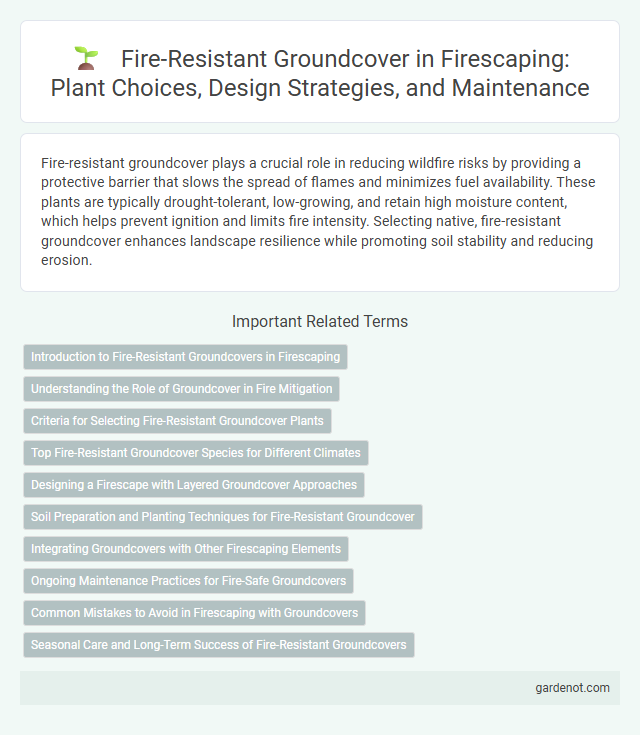Fire-resistant groundcover plays a crucial role in reducing wildfire risks by providing a protective barrier that slows the spread of flames and minimizes fuel availability. These plants are typically drought-tolerant, low-growing, and retain high moisture content, which helps prevent ignition and limits fire intensity. Selecting native, fire-resistant groundcover enhances landscape resilience while promoting soil stability and reducing erosion.
Introduction to Fire-Resistant Groundcovers in Firescaping
Fire-resistant groundcovers play a critical role in firescaping by reducing flammable vegetation near structures and offering a low-maintenance, fire-safe landscape solution. Species such as creeping sedum, ice plant, and California lilac resist ignition and slow wildfire spread with their high moisture content and low resin levels. Incorporating these plants strategically around homes and property boundaries minimizes fuel load and enhances overall wildfire defense.
Understanding the Role of Groundcover in Fire Mitigation
Fire-resistant groundcover acts as a crucial barrier that reduces the intensity and spread of wildfires by minimizing combustible material near structures. Selecting plants with high moisture content and low resin or oil levels, such as succulents and native grasses, effectively lowers the fire risk in landscapes. Properly maintained groundcover also aids in soil stabilization and prevents erosion, which further contributes to overall fire mitigation efforts.
Criteria for Selecting Fire-Resistant Groundcover Plants
Fire-resistant groundcover plants must possess high moisture content, low resin or sap levels, and minimal accumulation of dead or dry material to reduce fuel load effectively. Ideal species demonstrate slow growth with dense, green foliage, which inhibits flame spread and resists ignition even under extreme heat. Selecting native, drought-tolerant plants adapted to the local climate enhances long-term resilience and sustainability in defensible space design.
Top Fire-Resistant Groundcover Species for Different Climates
Effective firescaping incorporates fire-resistant groundcover species tailored to specific climates to reduce wildfire risk. In Mediterranean climates, drought-tolerant plants like Ice Plant (Delosperma) and Creeping Thyme (Thymus serpyllum) provide excellent fire resistance with their low resin and moisture-retaining foliage. For temperate zones, species such as Ajuga (Ajuga reptans) and Sedum varieties offer dense coverage and low flammability, while in arid regions, native succulents like Agave and certain ornamental grasses with high mineral content minimize fire spread and promote landscape resilience.
Designing a Firescape with Layered Groundcover Approaches
Designing a firescape with fire-resistant groundcover involves selecting drought-tolerant, low-flammability plants such as sedum, ice plant, and creeping thyme to form a protective layer against wildfires. Incorporating diverse groundcover layers reduces fuel continuity and helps create defensible space, minimizing fire spread risks near structures. Strategically placing non-combustible mulch materials, like gravel or decomposed granite, enhances fire resistance and supports moisture retention around these plants.
Soil Preparation and Planting Techniques for Fire-Resistant Groundcover
Effective soil preparation for fire-resistant groundcover involves deep tilling to enhance drainage and incorporating organic matter that retains moisture. Selecting drought-tolerant, low-flammability plants such as creeping sedum or ice plant promotes safety and resilience. Proper planting techniques include spacing plants to prevent overcrowding and mulching with non-combustible materials to reduce fire spread risk.
Integrating Groundcovers with Other Firescaping Elements
Fire-resistant groundcovers such as creeping thyme, sedum, and ice plant create a low-flammability base that complements hardscaping features like stone pathways and gravel mulches in firescaping design. Integrating these groundcovers with strategically placed fire-resistant shrubs and trees enhances the overall defensible space by minimizing ignition sources and slowing fire spread near structures. Effective layering of groundcovers beneath taller vegetation and adjacent to fire breaks improves landscape resilience against wildfires while maintaining aesthetic appeal.
Ongoing Maintenance Practices for Fire-Safe Groundcovers
Fire-resistant groundcover such as creeping thyme, ice plant, and sedum require regular pruning and removal of dead foliage to maintain their fire-retardant properties. Irrigation management is crucial to keep these plants healthy and reduce dry, flammable material buildup. Consistent monitoring for pests and diseases also ensures the groundcover remains dense and effective as a fire barrier in firescaping design.
Common Mistakes to Avoid in Firescaping with Groundcovers
Choosing fire-resistant groundcovers is crucial in firescaping to reduce fire hazards, but common mistakes include planting highly flammable species like dry grasses or resinous shrubs near structures. Overlooking proper spacing and maintenance, such as allowing dense growth without thinning or removing dead material, can create continuous fuel beds that facilitate fire spread. Ensuring adequate clearance around buildings and selecting low-growing, moisture-retentive plants like succulents or herbaceous perennials effectively minimizes wildfire risks in landscape design.
Seasonal Care and Long-Term Success of Fire-Resistant Groundcovers
Fire-resistant groundcovers such as ice plant, sedum, and creeping thyme require seasonal pruning and watering adjustments to maintain their drought tolerance and reduce fire fuel buildup. Regular removal of dead leaves and debris minimizes flammable material, ensuring the groundcover remains effective as a fire barrier. Consistent soil health management with mulching and proper irrigation promotes long-term resilience and sustained fire resistance.
Fire-resistant groundcover Infographic

 gardenot.com
gardenot.com